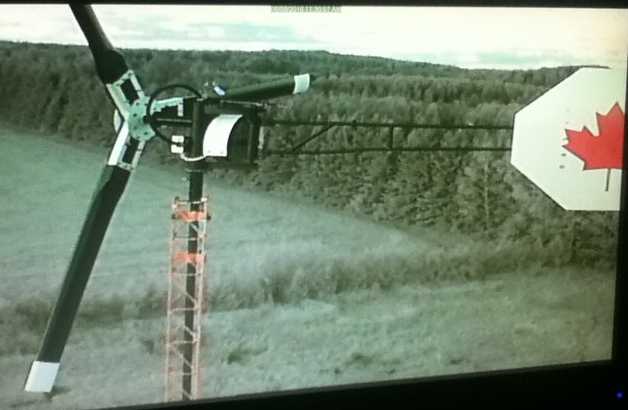Chris sent me this photo of one of his chain-driven machines, taken with a security camera mounted on a neighbouring turbine.
This is a photo of one of my 12G turbines on a 200 foot tower that powers an off-grid home in the Boreal Forest of Central Ontario, Canada. The photo was taken by a remote control security camera mounted on the adjacent tower which also has a 12G turbine on it. These two machines, combined, have averaged 32 kWh a day on those 200 foot towers, meaning they have each produced an average of 660 watts, 24 hours a day.
These machines are hard at work every day up there, 175 miles from the nearest grid power lines, and the only way you can get to this location where the turbines are is by float plane. The nearest road, which is just an old logging road that’s not used anymore, is about 40 miles away. I hauled these turbines up there in May with a De Havilland DHC-2 Beaver converted with a Pratt & Whitney PTA6-A turbine engine in it with 750 shaft hp. I landed on MacDowell Lake when I delivered the turbines to the remote fishing camp where they are installed.
some people have all the fun 🙂



amazing work chris, hats off to you.
Wow ! A 200ft tower! That’s really grabbing the bull by the horns. It’s the only way of dealing with lots of trees. In BC, we have another way of dealing with trees…clear-cut them. As an eco-guy, I prefer the tall tower solution.
A lot of those trees up there are old mature pines and they tower 60-90 feet in the air. The tall towers is the only way to get the turbines up into “clean” air where they really perform.
The towers are tilting and are salvaged military VOR array towers. They use a cable, pulley and winch rigging similar to a crane boom to raise themselves. The hard part was raising the first tower. But once it is up, the first tower is used to raise the second one. And once the second one is up, it is used to lower the first one and raise it.
Quite an ingenious system to raise and lower tall towers, although I did not design that part of it.